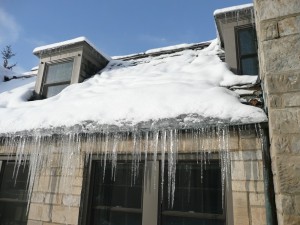
What Is An Ice Dam
An ice dam is a ridge of ice that forms at the edge of a roof and prevents melting snow from draining off the roof. The water that backs up behind the dam can leak into your home and cause damage to walls, ceilings, insulation, and other areas. Then you have the havoc ice dams wreak
What Causes Ice Dams?
For ice dams to form there must be snow on the roof and the higher parts of the roof’s outside surface must be above 32 degrees F while the lower surfaces are below 32. For the lower part of the roof to be below 32, the outside temperature must be below 32 for an extended period of time.
The snow on a roof surface that is above 32 will melt. As water flows down the roof it reaches the portion of the roof that is below 32 and freezes. And before you know it, you have an ice dam.
Soon the dam grows as the snow melts from above it. The dam will limit itself to the portions of the roof that are on the average below 32. So, the water above backs up behind the ice dam and remains a liquid. This water finds cracks and openings in the exterior roof covering and flows into the attic space. From the attic it could flow into exterior walls or through the ceiling insulation and stain the ceiling finish whether it be painted, stained, etc..
It should be noted, contrary to popular belief, gutters do not cause ice dams. However, gutters do help to concentrate ice and water in the very vulnerable area at the edge of the roof. Subsequently, as gutters fill with ice, they often bend and rip away from the house, bringing fascia, fasteners, and downspouts in tow.
It should be noted, roofs leak on attic insulation. In the short term, wet insulation doesn’t work well. Over the long term, water-soaked insulation remains compressed, so that even after it dries, the R-value is not as high. The lower the R-values, the more heat lost. Therefore, this sets up a vicious cycle: heat loss-ice dams-roof leaks-insulation damage-more heat loss! Cellulose insulation is particularly vulnerable to the hazards of wetting.
Of course, water often leaks down inside the wall, where it wets wall insulation and causes it to sag, leaving uninsulated voids at the top of the wall. Again, energy dollars disappear, but more importantly, moisture gets trapped in the wall cavity between the exterior plywood sheathing and the interior vapor barrier. Soon you can smell the result. In time, the structural framing members may decay. Metal fasteners may corrode. Mold and mildew may form on the surface of the wall. Exterior
and interior paint blisters and peels. As a result, people with allergies suffer.
Peeling paint deserves special attention here because it may be hard to recognize what’s causing it. Wall paint doesn’t usually blister or peel while the ice dams are visible. Paint peels long after the ice—and the roof leak itself—have disappeared. Water from the leak infiltrates wall cavities. It dampens building materials and raises the relative humidity inside the wall. The moisture within the wall cavity tries to escape (as either liquid or vapor) and wets the interior and
exterior walls. As a result, the walls shed their skin of paint.
Solving the Problem
Without a doubt, the way to stop ice dams from forming is to keep the entire roof cold. In most homes this means blocking all air leaks leading to the attic from the living space below, increasing the thickness of insulation on the attic floor, and installing a continuous soffit and ridge vent system. Be sure that the air and insulation barrier you create is continuous.
Furthermore, don’t waste time or money placing electric heat tape on the shingles above the edge of the roof. Electrically heated cable rarely, if ever, solves the problem. It takes a lot of electricity to prevent ice formation; and the heating must be done before it gets cold enough for ice dams to form, not afterwards. Over time, heat tape makes shingles brittle. It’s expensive to install, too, and water can leak through the cable fasteners. And often the cables create ice dams just above them.
Undoubtedly, the worst of all solutions is shoveling snow and chipping ice from the edge of the roof. People attack mounds of snow and roof ice with hammers, shovels, ice picks, homemade snow rakes, crowbars, and chain saws! The theory is obvious. No snow or ice, no leaking water. Unfortunately, this method threatens life, limb, and roof.
Clearly, the best solution to the havoc ice dams wreak, is if at all possible, when the weather clears consider finding the problem and make the proper repairs. When the next snow season rolls around, the ice dam escapade will not happen again.


Recent Comments